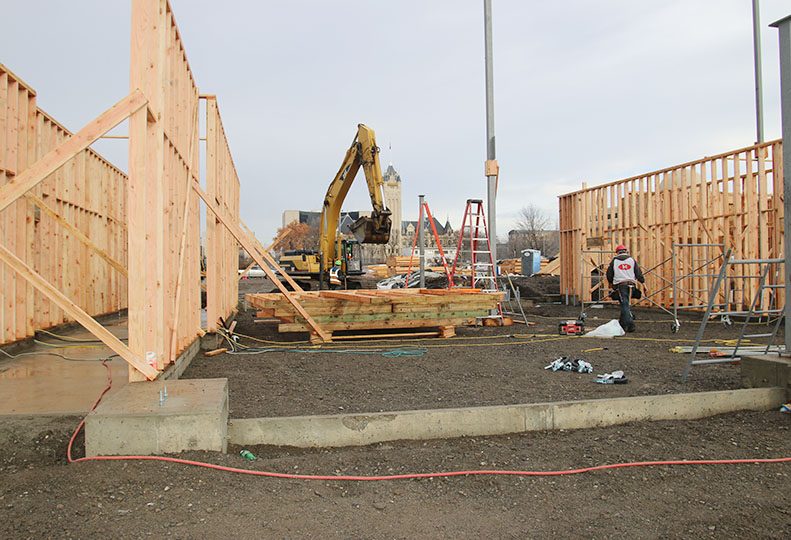
Home » Timber industry anticipates modest, continuous rise
Timber industry anticipates modest, continuous rise
-

December 18, 2014
With slow but steady continued growth in U.S. housing starts, optimism is the key word for the wood products sector in 2015.
Wood product makers remain cautiously upbeat as they keep watch on commercial and residential markets, the latter of which accounts for more than 80 percent of sales, including for new housing and remodeling projects, say economists and industry observers.
Shawn Church, editor of Eugene, Ore-based Random Lengths, a publication that tracks lumber prices, says 2014 was a good year for most wood products.
“Prices were up. There was higher demand for wood products, and housing starts were up from the previous year,” Church says.
He says that based on information from national reader surveys, housing starts likely will finish the year at just under 1 million, and they’re expected to be in the range of 1 million to 1.2 million in 2015. Church says those numbers match what Forest Economic Advisors LLC, another industry analyst, is predicting for next year.
Single-family housing starts continue to dominate the market, he says, but multifamily housing starts rose this year to 35.6 percent of market share from 31.1 percent in 2013.
“It’s not only higher than last year,” he says, “but it’s the highest it’s been since 1985.”
Lumber consumption has been up as well, he says, with lumber volume available to the U.S. market through the third quarter of 2014 at 3.7 billion board feet, which is a 6.5 percent increase over 2013.
Limiting the upside of the economic recovery, he adds, is the inability of some buyers to qualify for mortgages, as well as some concern over the global economy.
“There have also been problems moving wood products because of weather-related rail delays this year,” he says, “and the trucking industry has been a big problem.” Church says mostly the problem is truck driver availability. “We’ll be watching that closely to see if truck rates rise, but it’s still an issue.”
Northwest Farm Credit Services, the Spokane-based agricultural lender, says after a slow start in 2014, the economy vastly improved, but recovery in the housing sector was slower than expected. NFCS reports say Federal Reserve projections show housing starts should rise to 1.2 million in 2015, supporting future demand increases for forest products.
Lumber and panel prices fell high and low for the first three quarters of 2014, and weakened in September due to lower demand. Year-end figures will show a roughly 3 percent increase in demand for lumber and panels during the latter part of 2014, and that demand will see a 7 percent increase in 2015, driven primarily by domestic home construction, the NFCS reports.
Overall, Northwest Farm Credit says, analysts predict an increase, albeit slow, in domestic lumber demand in 2015, resulting in elevated prices throughout the Northwest forest product industry.
Joel White, executive officer of the Spokane Home Builders Association, says 2014 started off positive in Spokane County, with up to a 30 percent increase in home building permits, but started to soften mid-year.
“We lost some steam. I think it may be due to the public confidence over where the economy is heading,” White says. “We were also seeing more sales in the $300,000-plus new homes, new construction market with more custom homes, but now that’s not as strong. We’ve leveled off some.”
Potlatch Corp., of Spokane, bought 201,000 acres of timberlands in Alabama and Mississippi for $384 million. The acquisition was completed in mid-December. The gain is expected to expand Potlatch’s ownership in the southern U.S. by almost 50 percent and will increase its total acreage to nearly 1.6 million acres.
The company announced third-quarter net income of $33.2 million, or 81 cents a diluted share, up from income of $22.2 million, or 54 cents a share, in the year-earlier period.
The increased earnings came on $177.2 million in revenue during the third quarter, up from $157.9 million in the year-earlier period.
Clearwater Paper Corp., of Spokane, reported third-quarter net income of $6.3 million, or 31 cents a diluted share, compared with income of $13.3 million, or 60 cents a share, in the year-earlier period. The company attributed the decline in earnings, in part, to $15.8 million in debt-retirement costs and $3.1 million in expense with the closure of facilities in Georgia and New York.
—Judith Spitzer
Special Report
Related Articles




